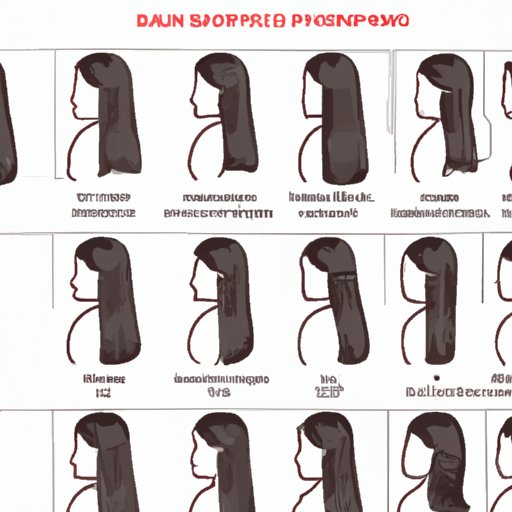Introduction
Long hair has been a source of beauty and fascination for centuries. But what is considered to be long hair? According to the Merriam-Webster dictionary, long hair is defined as “hair that is longer than shoulder-length.” In this article, we will explore what is considered long hair, examining different lengths, how to grow and maintain it, the benefits of having long hair, its history and cultural significance, common myths about long hair, tips for caring for long hair, and popular hairstyles for long hair.
Examining the Different Lengths of Long Hair
The length of long hair can vary from person to person, depending on individual factors such as age, gender, genetics, and lifestyle choices. Some people may consider waist-length hair to be long hair, while others may think that anything beyond shoulder-length is considered long. Common lengths of long hair include mid-back, bra strap, armpit, hip, and waist-length.

How to Grow and Maintain Long Hair
Growing and maintaining long hair can be a challenge, but with patience and dedication, you can achieve your desired length. It is important to give your hair the proper care it needs in order to promote healthy growth. Here are some basic tips:
- Eat a balanced diet rich in protein and vitamins, which are essential for strong and healthy hair.
- Exercise regularly to improve circulation, which helps to stimulate hair growth.
- Avoid using heat styling tools too often as they can damage your hair.
- Limit or avoid chemical treatments such as coloring and bleaching, as these can weaken the hair shaft.
- Use a mild, sulfate-free shampoo and conditioner to keep your hair clean and hydrated.
- Deep condition your hair once a week to keep it nourished and moisturized.
- Protect your hair from the sun and wind by wearing a hat or scarf.
- Trim your ends every 6-8 weeks to prevent split ends and breakage.

The Benefits of Having Long Hair
Having long hair comes with many benefits, both physical and psychological. Physically, long hair can help protect your scalp from the sun’s harmful UV rays, keeping it healthy and preventing skin cancer. Long hair also helps to keep your head and neck warm during colder months. Psychologically, long hair can be a great confidence booster, making you feel more attractive and feminine. It can also be a great way to express yourself and show off your unique style.

History and Cultural Significance of Long Hair
Long hair has been a part of many cultures throughout history, with some societies viewing it as a sign of beauty, strength, and power. In ancient Egypt, long hair was seen as a symbol of wealth and status, and was often worn in elaborate styles. In ancient Greece, long hair was viewed as a sign of youth and fertility, and was often associated with gods and goddesses. In medieval Europe, long hair was seen as a sign of nobility, and was worn by both men and women. In modern times, long hair continues to be seen as a sign of beauty and femininity.
Common Myths About Long Hair
There are many misconceptions and myths surrounding long hair. One of the most common is that long hair is harder to maintain. While it is true that long hair requires more care and attention than short hair, it is not necessarily more difficult to maintain. Another myth is that long hair is only for women. While historically long hair has been associated with femininity, there is no reason why men cannot wear their hair long. Other myths about long hair include that it is unhealthy, or that it is not suitable for certain professions.

Tips for Caring for Long Hair
Caring for long hair is an important part of maintaining its health and appearance. Here are some basic tips to keep in mind:
- Brush your hair daily to distribute natural oils and prevent tangles.
- Wash your hair 2-3 times a week with a mild, sulfate-free shampoo.
- Use a deep conditioner once a week to keep your hair hydrated and nourished.
- Avoid using heat styling tools too often, as they can damage your hair.
- Limit or avoid chemical treatments such as coloring and bleaching, as these can weaken the hair shaft.
- Trim your ends every 6-8 weeks to prevent split ends and breakage.
Popular Hairstyles For Long Hair
Long hair gives you the opportunity to experiment with different hairstyles and show off your creative side. Popular hairstyles for long hair include braids, buns, ponytails, half-up/half-down styles, and beach waves. If you’re looking for something more daring, you can try out more complex styles such as French twists, fishtail braids, and updos. When styling your hair, be sure to use products that are specifically designed for long hair, such as leave-in conditioners, volumizing mousses, and curl defining creams.
Conclusion
We have explored what is considered long hair, examining different lengths, how to grow and maintain it, the benefits of having long hair, its history and cultural significance, common myths about long hair, tips for caring for long hair, and popular hairstyles for long hair. With patience and dedication, anyone can achieve their desired length and maintain healthy, beautiful hair. Whether you choose to keep it natural or experiment with different styles, long hair can be a great way to express yourself and show off your unique style.


